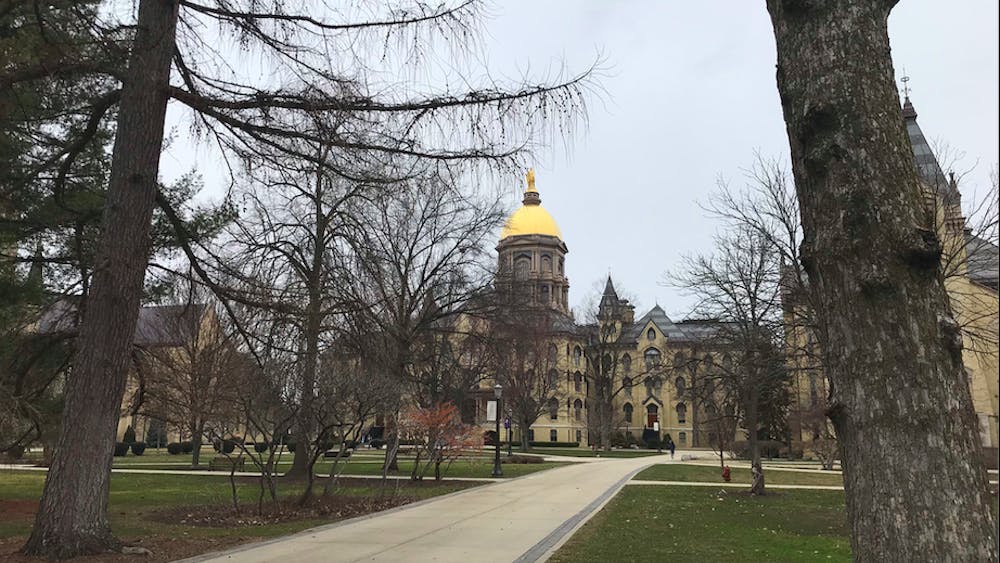The daily music selection at Notre Dame's North Dining Hall is one of its unique features.
Varying from early-2000s hits to ’80s throwbacks, the diverse song selection contributes to the dining hall’s overall ambiance and has led to speculation as to whether the choices are deliberate.
Every day, students eat, socialize and study at North Dining Hall. Chris Abayasinghe, director of Campus Dining, said that over 2.2 million meals are served each year between the two halls and the majority of those meals are served at North Dining Hall.
During the holiday season, students can listen to Mariah Carey’s “All I Want for Christmas is You” while in line for Southwest Salad, and during football season, members of the community sing along to University classics such as the Notre Dame Fight Song at tailgate dinners, leading students to wonder about the identity of the creator of these mysterious playlists.
The playlist is also not actually a playlist, but a rotation of carefully-selected stations on the satellite radio service, Sirius XM. The curator or creator of these stations is not a single person, but rather a combination of input from the Dining Hall staff and suggestions from students.
William Krusniak, a manager at North Dining Hall, helps select the SiriusXM stations played each day. Krusniak revealed the stations on this normal rotation.
“’90s on 9, ‘80s on 8, Pop2K, The Blend, The Pulse,” he said. “There’s usually about five to six channels.“
Krusniak explained that the selection is also influenced by what time of day it is.
“In the morning, the managers like to have more of an older, set-back style like Classic Rewind,” he said.
Krusniak also said the changing seasons factor into the selection decisions.
"It’s the feel,“ Krusniak said. ”On game day, I’m going to crank it up. Make sure there’s more hype, faster music. We consider who’s the visiting team, what area of the country. On Thanksgiving, it’s more of a jazzy Sinatra style. On Fat Tuesday, we’re going to have more of a New Orleans blues [style].”
Student employees sometimes offer suggestions for stations played, Krusniak said, but there is no official job position for a dining hall DJ. While students have made Spotify playlists for North Dining Hall, including ”Kind of a Big Dill” and ”Don’t Go Bacon My Heart,“ they are not actually played within the dining halls.
However, Abayasinghe and Luigi Alberganti, director of Notre Dame Student Dining, said they were not opposed to the idea.
”We’ve never considered it before,“ Abayasinghe said. ”I would be open to that conversation … We would have to write up a job description for that [position].“
Music is not the only way the dining hall adjusts its ambiance with changing seasons. Food is also intentionally tailored to visiting groups. For example, signature Chinese dishes were featured on Lunar New Year. In addition, over 36% of all campus dining food venues are vegetarian or vegan to accommodate many dietary restrictions, Abayasinghe said.
The culinary staff at Notre Dame are chosen through a ”super selective“ process, Abayasinghe said.
“We train them right,“ he said. ”We make the investment to bring in celebrity chefs to help.”
Abayasinghe said celebrity chefs that have aided in training the Notre Dame culinary staff include Rohan Marley, son of reggae music artist Bob Marley; Jet Tila, who has appeared on the Food Network programs like Chopped and Iron Chef America; Jehangir Mehta, an expert on plant based proteins; and Suvir Saran, an author of various Indian cookbooks.
The University has also worked to reduce the amount of dining hall food waste, Abayasinghe said.
In 2019, Campus Dining initiated a Grind 2 Energy process in collaboration with the Office of Sustainability. This effort was also inspired by the statistic that “over 40% of food that is grown harvested is not consumed and thrown away,” Abayasinghe said.
The large cylindrical units outside both dining halls grind food waste into a slurry — part of a composting procedure. This slurry is sent off to farms and goes through anaerobic digestion, resulting in electricity, heat, renewable natural gas and transportation fuels. In 2019, according to a sustainability report from Abayasinghe, the slurry waste from North Dining Hall was used to power 15 homes for one month.
New traditions and improvements continue to shape both dining halls and make them increasingly more distinct from each other. For instance, a defining feature of South in the early 1920s was the sale of cigarettes and a song called “The Buns of Notre Dame.” Today, traditions include clapping when a cup is dropped on the floor of South.
Additionally, renovations that cannot take place at South have been recently implemented in North, including the new stir fry system.
Abayasinghe encourages anyone with suggestions on how to improve Campus Dining to submit them using the QR codes found on dining hall napkin holders or on their website.
Read More
Trending









